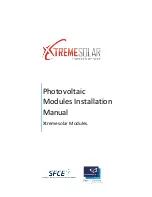
●
Antisepsis: keep away from salt erode and sulfuration places
5
、
Mounting and notes
●
The modules’ electrical performance in a system is the same. When connected in series, all modules must
have the same amperage. When connected in parallel, the modules must all have the same voltage. Connect
the quantity of modules that match the voltage specifications of the devices used in the system. The modules
must not be connected together to create a voltage that is higher than the permitted system voltage.
●
To minimize risk in the event of an indirect lightning strike, avoid forming loops when designing the system.
●
Modules must not be fitted as overhead glazing. Ensure that the mounting system can also withstand the
anticipated wind and snow loads.
●
Precipitate can run off through small openings on the back side of the module. Make sure that the openings are
not masked after mounting.
●
The maximum load on the module must not exceed 2.4kN
/㎡.
To avoid exceeding the maximum load,
site-specific live loads such as wind and snow should be taken into account.
●
The installation of project must be facing north in the southern hemisphere, and facing south in the northern
hemisphere, the electricity will be comparatively lower when the project facing west or east. The incorrect
installation will lead to the loss of power
●
The modules, which are connected in series, must be in the same angle, otherwise, it will lose power because
of the difference in sunlight intensity. Solar modules generate the power to the maximum when they are
pointed directly at the sun. For installations where the solar modules are mounted to a permanent structure,
the solar modules should be tilted for optimum winter performance. As a rule, if the system power output is
adequate in the winter, it will be satisfactory during the rest of the year. The module tilt angle is measured
between the solar modules and the ground.
RECOMMENDED TILT ANGLES FOR A FIXED SYSTEM
SITE LATITUDE IN DEGREES
FIXED TILT ANGLE
0
o
TO 15
o
15
o
15
o
TO 25
o
SAME AS LATITUDE
25
o
TO 30
o
L5
o
30
o
TO35
o
L10
o
35
o
TO 40
o
L15
o
40
o
+
L20
o




























